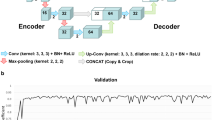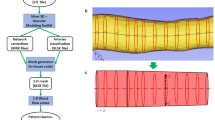Abstract
Head and neck postures may cause morphology changes to the geometry of the carotid bifurcation (CB) that alter the low and oscillating wall shear stress (WSS) regions previously reported as important in the development of atherosclerosis. Here the right and left CB were imaged by MRI in two healthy subjects in the neutral head posture with the subject in the supine position and in two other head postures with the subject in the prone position: (1) rightward rotation up to 80°, and (2) leftward rotation up to 80°. Image-based computational models were constructed to investigate the effect of posture on arterial geometry and local hemodynamics. The area exposure to unfavorable hemodynamics, based on thresholds set for oscillatory shear index (OSI), WSS and relative residence time, was used to quantify the hemodynamic impact on the wall. Torsion of the head was found to: (1) cause notable changes in the bifurcation and internal carotid artery angles and, in most cases, on cross-sectional area ratios for common, internal and external carotid artery, (2) change the spatial distribution of wall regions exposed to unfavorable hemodynamics, and (3) cause a marked change in the hemodynamic burden on the wall when the OSI was considered. These findings suggest that head posture may be associated with the genesis and development of atherosclerotic disease as well as complications in stenotic and stented vessels.






Similar content being viewed by others
References
Anayiotos AS, Jones SA, Giddens DP, Glagov S, Zarins CK (1994) Shear stress at a compliant model of the human carotid bifurcation. J Biomech Eng 116:98–106
Antiga L, Steinman DA (2004) Robust and objective decomposition and mapping of bifurcating vessels. IEEE Trans Med Imaging 23(6):704–713
Aristokleous N, Seimenis I, Papaharilaou Y, Georgiou GC, Brott BC, Eracleous E, Anayiotos AS (2011) Effect of posture change on the geometric features of the healthy carotid bifurcation. IEEE Trans Inf Technol Biomed 15(1):148–154
Balossino R, Pennati G, Migliavacca F, Formaggia L, Veneziani A, Tuveri M, Dubini G (2009) Computational models to predict stenosis growth in carotid arteries: which is the role of boundary conditions? Comput Methods Biomech Biomed Eng 12(1):113–123
Bao X, Lu C, Frangos JA (1999) Temporal gradient in shear but not steady shear stress induces PDGF-A and MCP-1 expression in endothelial cells: role of NO, NF kappa B, and egr-1. Arterioscler Thromb Vasc Biol 19:996–1003
Bijari PB, Antiga L, Wasserman BA, Steinman DA (2011) Scan-rescan reproducibility of carotid bifurcation geometry from routine contrast-enhanced MR angiography. J Magn Reson Imaging 33(2):482–489
Cheng CP, Wilson NM, Hallett RL, Herfkens RJ, Taylor CA (2006) In vivo MR angiographic quantification of axial and twisting deformations of the superficial femoral artery resulting from maximum hip and knee flexion. J Vasc Interv Radiol 17(6):979–987
Cho YI, Back LH, Crawford DW (1985) Experimental investigation of branch flow ratio, angle, and reynolds number effects on the pressure and flow fields in arterial branch models. J Biomech Eng 107(3):257–267
Glor FP, Ariff B, Hughes AD, Verdonck PR, Barratt DC, Augst AD, Thom SA, Xu XY (2004) Influence of head position on carotid hemodynamics in young adults. Am J Physiol Heart Circ Physiol 287(4):H1670–H1681
Glor FP, Long Q, Hughes AD, Augst AD, Ariff B, Thom SA, Verdonck PR, Xu XY (2003) Reproducibility study of magnetic resonance image-based computational fluid dynamics prediction of carotid bifurcation flow. Ann Biomed Eng 31(2):142–151
Gonzales RS, Wick TM (1996) Hemodynamic modulation of monocytic cell adherence to vascular endothelium. Ann Biomed Eng 24(3):382–393
Himburg HA, Grzybowski DM, Hazel AL, LaMack JA, Li XM, Friedman MH (2004) Spatial comparison between wall shear stress measures and porcine arterial endothelial permeability. Am J Physiol Heart Circ Physiol 286(5):H1916–H1922
Hoi Y, Wasserman BA, Lakatta EG, Steinman DA (2010) Effect of common carotid artery inlet length on normal carotid bifurcation hemodynamics. J Biomech Eng 132(12):121008
Ku DN, Giddens DP, Zarins CK, Glagov S (1985) Pulsatile flow and atherosclerosis in the human carotid bifurcation. Positive correlation between plaque location and low oscillating shear stress. Arteriosclerosis 5(3):293–302
Lee SW, Steinman DA (2007) On the relative importance of rheology for image-based CFD models of the carotid bifurcation. J Biomech Eng 129(2):273–278
Lee SW, Antiga L, Spence JD, Steinman DA (2008) Geometry of the carotid bifurcation predicts its exposure to disturbed flow. Stroke 39(8):2341–2347
LoGerfo FW, Nowak MD, Quist WC, Crawshaw HM, Bharadvaj BK (1981) Flow studies in a model carotid bifurcation. Arteriosclerosis 1:235–241
Malek AM, Alper SL, Izumo S (1999) Hemodynamic shear stress and its role in atherosclerosis. JAMA 282(21):2035–2042
Mitsumori LM, Hatsukami TS, Ferguson MS, Kerwin WS, Cai J, Yuan C (2003) In vivo accuracy of multisequence MR imaging for identifying unstable fibrous caps in advanced human carotid plaques. J Magn Reson Imaging 17(4):410–420
Morbiducci U, Gallo D, Massai D, Consolo F, Ponzini R, Antiga L, Bignardi C, Deriu MA, Redaelli A (2010) Outflow conditions for image-based hemodynamic models of the carotid bifurcation: implications for indicators of abnormal flow. J Biomech Eng 132(9):091005
Morbiducci U, Gallo D, Massai D, Ponzini R, Deriu MA, Antiga L, Redaelli A, Montevecchi FM (2011) On the importance of blood rheology for bulk flow in hemodynamic models of the carotid bifurcation. J Biomech 44(13):2427–2438
Moyle KR, Antiga L, Steinman DA (2006) Inlet conditions for image-based CFD models of the carotid bifurcation: is it reasonable to assume fully developed flow? J Biomech Eng 128(3):371–379
Papaharilaou Y, Doorly DJ, Sherwin SJ (2002) The influence of out-of-plane geometry on pulsatile flow within a distal end-to-side anastomosis. J Biomech 35(9):1225–1239
Perktold K, Resch M, Peter RO (1991) Three-dimensional numerical analysis of pulsatile flow and wall shear stress in the carotid artery bifurcation. J Biomech 24:409–420
Perktold K, Rappitsch G (1995) Computer simulation of local blood flow and vessel mechanics in a compliant carotid artery bifurcation model. J Biomech 28:845–856
Roger VL, Go AS, Lloyd-Jones DM, Adams RJ, Berry JD, Brown TM, Carnethon MR, Dai S, de Simone G, Ford ES, Fox CS, Fullerton HJ, Gillespie C, Greenlund KJ, Hailpern SM, Heit JA, Ho PM, Howard VJ, Kissela BM, Kittner SJ, Lackland DT, Lichtman JH, Lisabeth LD, Makuc DM, Marcus GM, Marelli A, Matchar DB, McDermott MM, Meigs JB, Moy CS, Mozaffarian D, Mussolino ME, Nichol G, Paynter NP, Rosamond WD, Sorlie PD, Stafford RS, Turan TN, Turner MB, Wong ND, Wylie-Rosett J, American Heart Association Statistics Committee and Stroke Statistics Subcommittee (2011) Heart disease and stroke statistics–2011 update: a report from the american heart association. Circulation 123(4):e18–e209
Steinman DA, Taylor CA (2005) Flow imaging and computing: large artery hemodynamics. Ann Biomed Eng 33(12):1704–1709
Steinman DA, Thomas JB, Ladak HM, Milner JS, Rutt BK, Spence JD (2002) Reconstruction of carotid bifurcation hemodynamics and wall thickness using computational fluid dynamics and MRI. Magn Reson Med 47(1):149–159
Taylor CA, Draney MT (2004) Experimental and computational methods in cardiovascular fluid mechanics. Annu Rev Fluid Mech 36:197–231
Thomas JB, Milner JS, Rutt BK, Steinman DA (2003) Reproducibility of image-based computational fluid dynamics models of the human carotid bifurcation. Ann Biomed Eng 31(2):132–141
Tsao PS, Lewis NP, Alpert S, Cooke JP (1995) Exposure to shear stress alters endothelial adhesiveness. Role of nitric oxide. Circulation 92(12):3513–3519
Valibhoy AR, Mwipatayi BP, Sieunarine K (2007) Fracture of a carotid stent: an unexpected complication. J Vasc Surg Int Soc Cardiovasc Surg NA 45(3):603–606
Yushkevich PA, Piven J, Hazlett HC, Smith RG, Ho S, Gee JC, Gerig G (2006) User-guided 3D active contour segmentation of anatomical structures: significantly improved efficiency and reliability. Neuroimage 31(3):1116–1128
Zhang Q, Steinman DA, Friedman MH (2010) Use of factor analysis to characterize arterial geometry and predict hemodynamic risk: application to the human carotid bifurcation. J Biomech Eng 132(11):114505
Acknowledgments
This work was co-funded by the European Regional Development and the Republic of Cyprus through the Research Promotion Foundation (Project IPE/YGEIA/DYGEIA/0609/11 and DIAKRATIKES/CY-SLO/0609/01) and by grant GSRT-09FR37 of the General Secretariat for Research and Technology (GSRT), Greece.
Conflict of interest
The authors have no conflict of interest related to this study.
Author information
Authors and Affiliations
Corresponding author
Rights and permissions
About this article
Cite this article
Papaharilaou, Y., Aristokleous, N., Seimenis, I. et al. Effect of head posture on the healthy human carotid bifurcation hemodynamics. Med Biol Eng Comput 51, 207–218 (2013). https://doi.org/10.1007/s11517-012-0985-6
Received:
Accepted:
Published:
Issue Date:
DOI: https://doi.org/10.1007/s11517-012-0985-6




